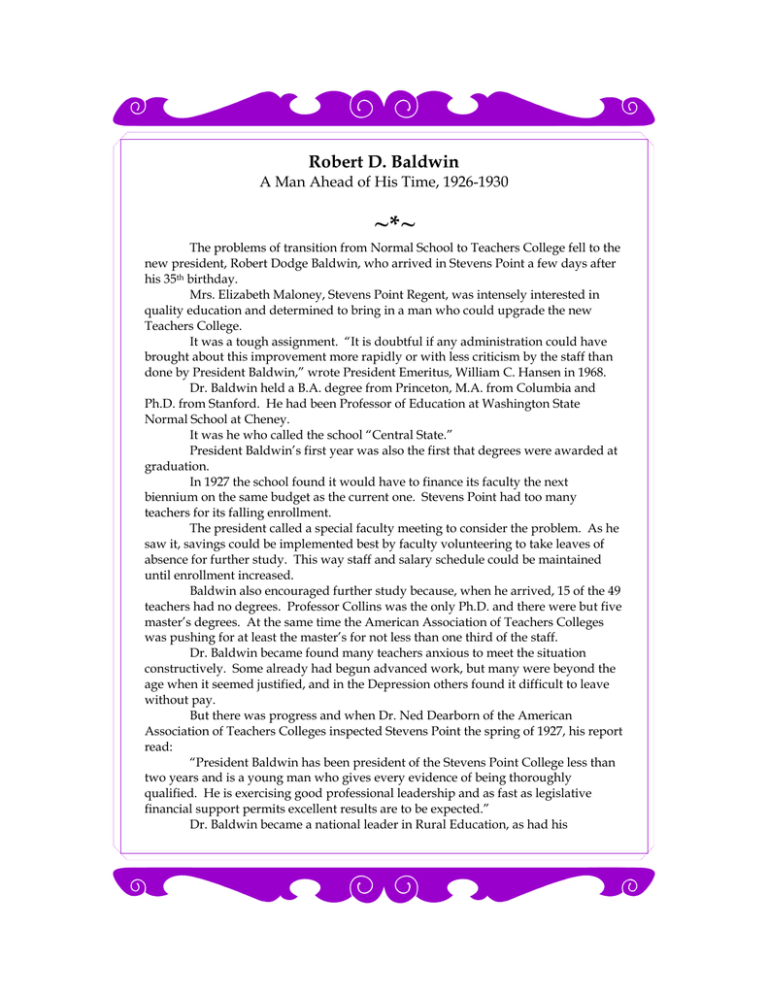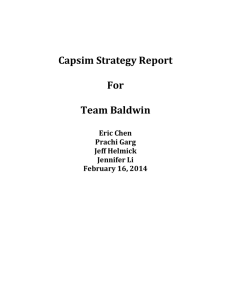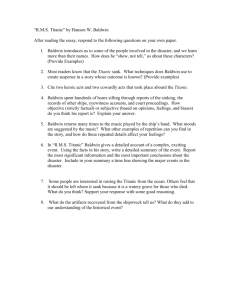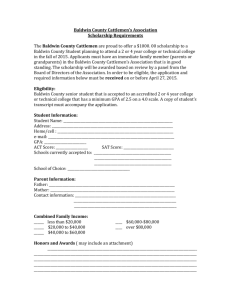~*~ Robert D. Baldwin A Man Ahead of His Time, 1926-1930
advertisement

Robert D. Baldwin A Man Ahead of His Time, 1926-1930 ~*~ The problems of transition from Normal School to Teachers College fell to the new president, Robert Dodge Baldwin, who arrived in Stevens Point a few days after his 35th birthday. Mrs. Elizabeth Maloney, Stevens Point Regent, was intensely interested in quality education and determined to bring in a man who could upgrade the new Teachers College. It was a tough assignment. “It is doubtful if any administration could have brought about this improvement more rapidly or with less criticism by the staff than done by President Baldwin,” wrote President Emeritus, William C. Hansen in 1968. Dr. Baldwin held a B.A. degree from Princeton, M.A. from Columbia and Ph.D. from Stanford. He had been Professor of Education at Washington State Normal School at Cheney. It was he who called the school “Central State.” President Baldwin’s first year was also the first that degrees were awarded at graduation. In 1927 the school found it would have to finance its faculty the next biennium on the same budget as the current one. Stevens Point had too many teachers for its falling enrollment. The president called a special faculty meeting to consider the problem. As he saw it, savings could be implemented best by faculty volunteering to take leaves of absence for further study. This way staff and salary schedule could be maintained until enrollment increased. Baldwin also encouraged further study because, when he arrived, 15 of the 49 teachers had no degrees. Professor Collins was the only Ph.D. and there were but five master’s degrees. At the same time the American Association of Teachers Colleges was pushing for at least the master’s for not less than one third of the staff. Dr. Baldwin became found many teachers anxious to meet the situation constructively. Some already had begun advanced work, but many were beyond the age when it seemed justified, and in the Depression others found it difficult to leave without pay. But there was progress and when Dr. Ned Dearborn of the American Association of Teachers Colleges inspected Stevens Point the spring of 1927, his report read: “President Baldwin has been president of the Stevens Point College less than two years and is a young man who gives every evidence of being thoroughly qualified. He is exercising good professional leadership and as fast as legislative financial support permits excellent results are to be expected.” Dr. Baldwin became a national leader in Rural Education, as had his predecessor. A portion of a speech he gave at the American Country Life Association in Urbana, Ill. was quoted in the New York Times in connection with New York’s rural problems and he was invited to New York City to speak in 1929. At home the academic program was strengthed, the faculty became involved in the decision making process, even in budget making, and the physical plant was expanded. After long and careful planning the new Training School opened in 1930. Here generations of pupils were to provide many college students with practice and laboratory situations as they studied under the guidance of specialists. Mrs. Maloney’s term expired, February 11, 1930. By then there was some discontent in the community with the president’s policies, but Mrs. Maloney was whole-hearted in his defense. There were faculty members who did not want to go on for graduate work. “They had nestled into a comfortable niche and had no intention of leaving it. And Baldwin’s attitude towards such revered activities as oratory and athletics was heretical” wrote President Emeritus Hanson. Governor Walter J. Kohler appointed W.E. Atwell, a local attorney, to replace Mrs. Maloney as Regent. There was no repetition of the furor of President Pray’s day. The president’s resignation was announced in Madison the day of summer school graduation. Dr. Baldwin later joined the University of West Virginia faculty, capping an eminent career with receipt of the Distinguished Service Award in School Administration from the American Association of School Administrators. He has been honored also at Stevens Point where Baldwin Hall on campus is named for him. By 1930 Bessie May Allen had carved out a big place for her Home Economics in the state and beyond. May Roach had few peers in enthusiasm and drive for Rural Education. Outstanding among the men with administrative responsibility were Herbert R. Steiner, Charles F. Watson and Oscar W. Neale. Others who were outstanding included George Allez, Lulu Mansour, Earl Roberts, Bertha Hussey, Frank Percival, Jessie Jones, Dell S. Garby, Clara Stroud, Florence Louise Brown (now Mrs. Palmer Tayler), Clarence D. Jayne and Eva M. Seen. ~*~





